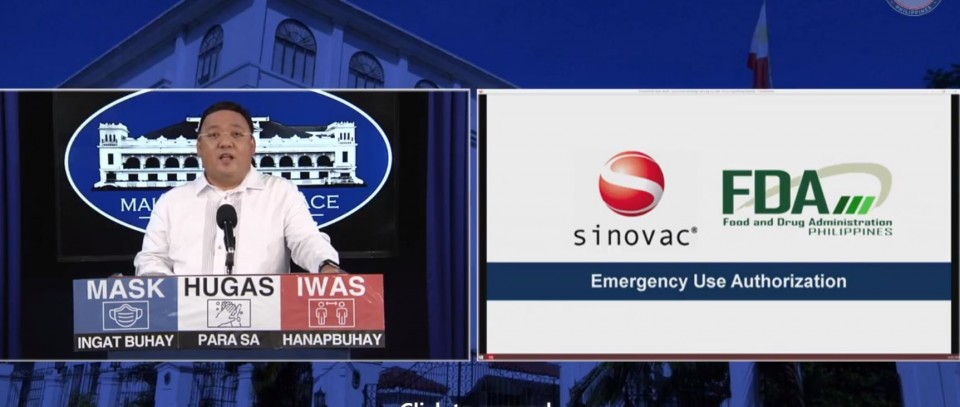EUA paves the way for the arrival of 600,000 doses of Sinovac vaccines in country; delivery in a matter of days

(Eagle News) – The Food and Drug Administration (FDA) has granted emergency use authorization (EUA) to China’s Sinovac vaccine paving the way for the arrival of some 600,000 doses of the said vaccines in the country.
Palace Spokesperson Harry Roque announced that this on Monday, Feb. 22, and said that hopefully the vaccines would be arriving in a matter of days.
“Sa wakas po parating na po ang ating mga bakuna. Natapos na po ang huling hadlang para magamit natin ang Sinovac para sa ating mga kababayan,” he said.
“Inaprubahan na po ng ating FDA ang emergency use authorization or EUA ng Sinovac at kinakailangan lamang ng China ng tatlong araw para maiparating sa atin ang Sinovac,” Roque said.
He said that hopefully, there will be no more delays for the arrival of the vaccines.
-Military, economic frontliners to receive Sinovac vaccines due to FDA restrictions
But the FDA said that Sinovac vaccines could only be given to those between 18 to 59 years old. The FDA said that the vaccines would also not be given to health care workers and senior citizens
Roque said that these were the two conditions given by the FDA in the EUA grant for Sinovac.
Because of this, those who would be given this vaccines are the military first, followed by the economic frontliners.
Since China early on had said that the 100,000 doses were being donated for the Philippine military, these first doses would be used first for the country’s soldiers.
The rest, or 500,000 doses which are also donated by China, will be given to the country’s economic frontliners, Roque said.
He said that that the National Immunization Advisory Group would have to revise its targets for prioritization because of the conditions set by FDA.
Instead of the frontliners being given the initial doses, it would be the military first and the economic frontliners that would be given the Sinovac vaccines.
-Use of inactivated virus-
The Sinovac vaccines have a reported 50 percent efficacy. It was developed using the traditional method of developing vaccines which is through inactivated virus.
“This approach uses technology that’s been proven to work in people – this is the way the flu and polio vaccines are made – and vaccines can be manufactured on a reasonable scale,” a World Health Organization primer on vaccines said.
The Sinovac’s vaccines are under the name Coronavac. It has been used in Phase 3 clinical trials in Brazil, Chile, Indonesia and Turkey.
Unlike other COVID-19 vaccines which used the messenger RNA, for example, or genetically modified cold viruses, Sinovac uses the centuries-old proven way of employing inactivated viruses.
The use of inactivated viruses dates back to the late 18th century, particularly, in 1796, when Edward Jenner, considered the founder of vaccinology in the West, inoculated a 13 year-old-boy with vaccinia virus (cowpox), and demonstrated immunity to smallpox. The vaccines against smallpox is the the first successful vaccine to be developed.
Sinovac’s Coronavac only requires ordinary refrigerator temperatures of 2 degrees C to 8 degrees Celsius for storage, the same temperatures at which flu vaccines are kept.
Brazil first announced on January 13 that Sinovac was 50.4% effective at preventing symptomatic infections, 78% effective in preventing mild cases needing treatment, and 100% effective in preventing severe cases.
Turkey, on the other hand, announced that Sinovac vaccines had an efficacy of 91.3 percent, while Indonesia — the first Southeast Asian country where Sinovac was used — reported an efficacy of 65.3 percent.
Since it uses the traditional inactivation process of producing vaccines, it has no reported severe side effects so far.
(Eagle News Service)








